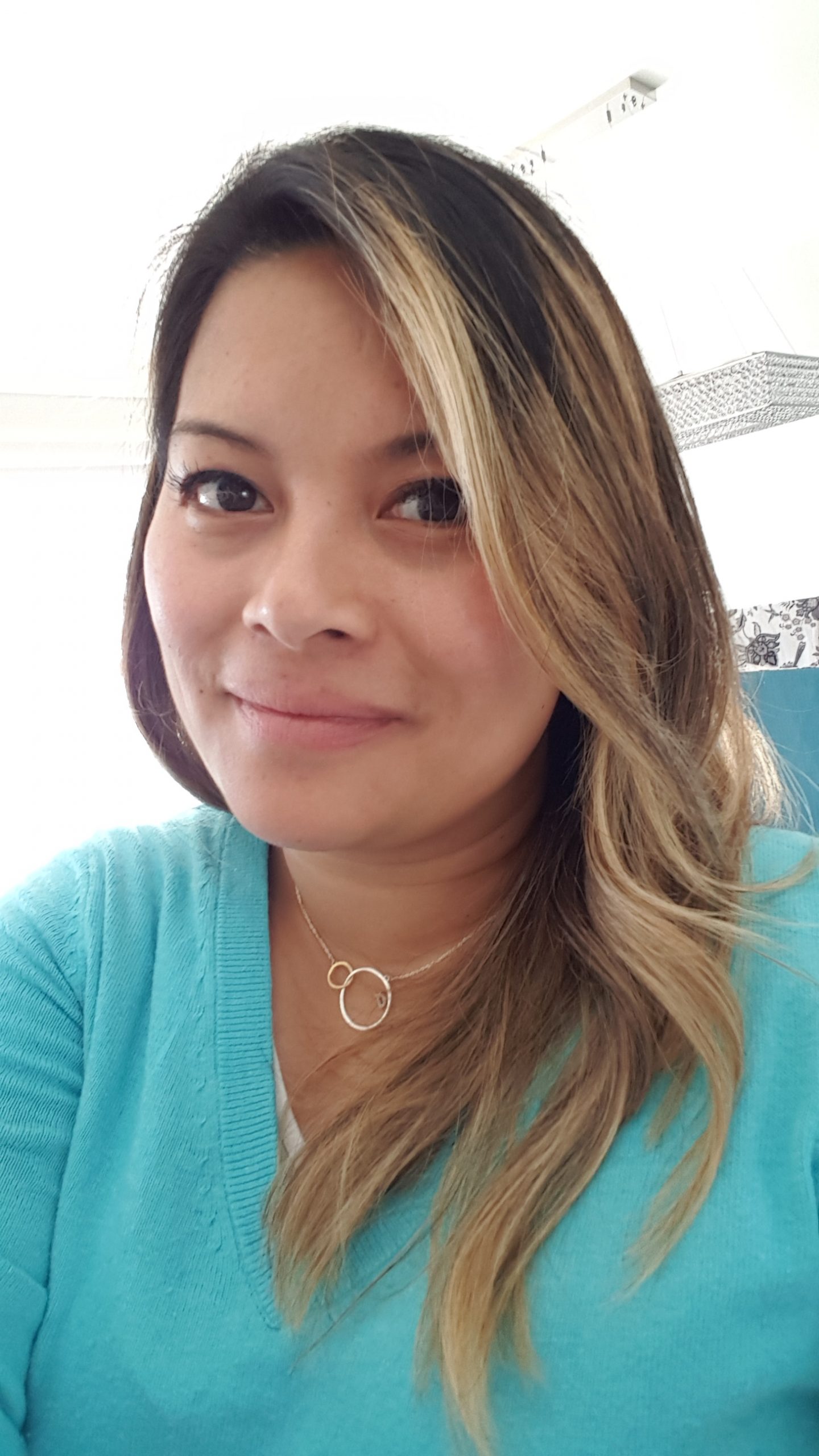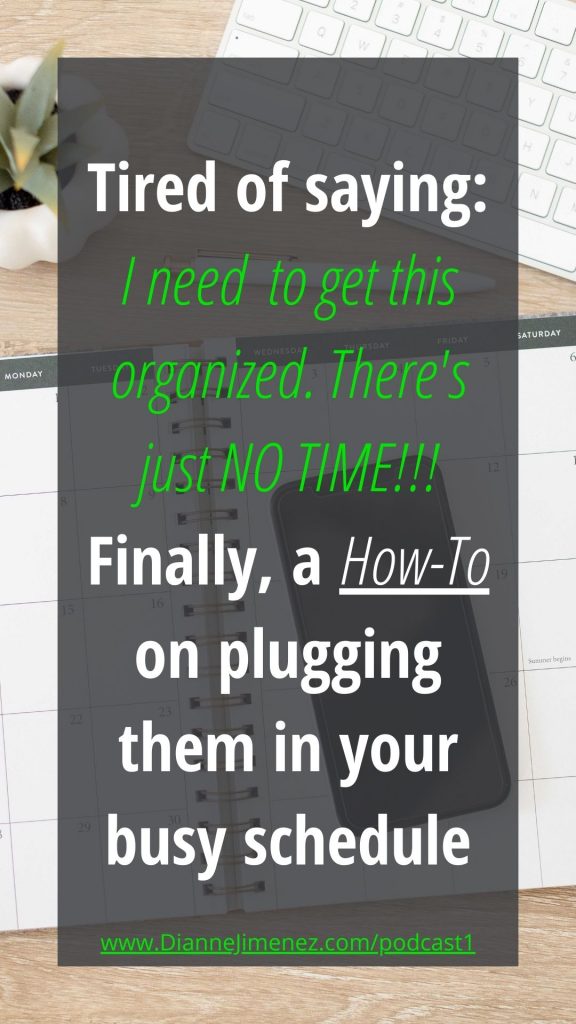5 Steps To Finding Time In A Busy Schedule
EPISODE 1

by Dianne Jimenez
This article takes 9 minutes to read
Don’t have time to read this? Listen to the podcast episode instead:
Subscribe to the
PARENTING GUIDE: ORGANIZING HABITS MADE EASY PODCAST
and never miss a bonus episode!
5 STEPS TO FINDING TIME IN A BUSY SCHEDULE
– Ugh I don’t know when I’m gonna get this done.
– I can’t do this until (insert the name of the person you need) is here to help.
– Sometimes I’m SO booked with driving here and there, doing everything for everyone, I barely have time to THINK about tackling the things I want to get done around the house.
Do you ever confide these to a friend or even say it under your breath? When it comes to getting something organized like your closet, the books scattered all over the house or the kids’ toys that are taking over the living room and now, into the kitchen???
Often we end up reorganizing and rage purging late in the evening and working well into the night. Next thing you know, we’re deep in clutter and in even MORE of a mess than when we first started. Other times, we feel guilty the next day because we got rid of something we MAYBE shouldn’t have.
These ill feelings are due to quick decisions based on emotions and frustrations and well, not allotting the appropriate amount of time to go through the process.
Want to go from 'drowning' to peace of mind?
Listen, we all have 24 hours in a day and how we spend that time is different from person to person from 1 day to the next. Ever wonder how come others can find the time to get things done, and it’s just not that easy for you?
Well I’m here to teach you my 5 steps to finding time in a busy schedule on my very first podcast episode. And it’s perfect to kick off the 1st month of the new year, also known in the organizing industry as GO month or Get Organized month – with a plan you can follow over and over again, for every organizing project you have AND stick to it.
Are you ready? Let’s do this !
So you know that space or that cluttered corner you’ve been meaning to tackle but just haven’t found the time to do it? But with every passing day, that nagging feeling in the back of your mind is growing and growing and…. growing.
When can you tackle this organizing project? There’s so many on your list, which one do you start with? How do you decide?
find out how families with 3+ kids tackle the beast: laundry!
Step 1 – To Finding Time:
Take 10 minutes to list all that you want to get organized. No editing, no order. Just brain dump it all on a piece of paper
The only thing you have to be specific about is the verb or action you’re putting at the beginning. So for instance, don’t just write “kids’ clothes”.
Actually write:
- Organize and categorize kids’ clothes: If you need to get extra supplies like labels and bins, write that down too.
- Organizing your food containers: do the bases have their lids? How stained and worn are they? Do they smell weird or are your containers constantly overflowing? It’s always a mess.
- Organizing the toys: because it’s taking over the living room, basement, kids rooms and now, the dining area.
- Converting the baby room: Now that you’re done with the baby phase what is needed to set up the room for the next stage of their life? What furniture do you need to get or dispose of?
- Implement a chore chart: Since the kids are getting a little older, who can do what, based on their age and abilities.
How to get your kids started with laundry
Step 2 – To Finding Time:
Pick 1 project.
How? What needs to get done first? Prioritize…
…what is the most stressful for you ?
…where’s the blockage in your every day, natural flow of daily activities? Is it you or your kids not knowing what to wear in the morning? Perhaps you get stumped with deciding what to make for dinner with homework, baths and pm routine right around the corner.
Another way of going about this step is to go with physical cues. What is a total eyesore for you or what has been piling up that’s causing your eye to twitch every time you pass by it?
The opposite can help: looking at things in a more positive light like: Which project is the EASIEST that will result in more motivation and give you momentum that you’ll be inclined to keep going !
Take another 10 minutes for this step. Don’t think too much about it. The goal is to pick 1 project that sticks out to you the most.
Congrats! You’ve tackled the biggest part of this whole process:
Deciding to focus on ONE thing
Often, this is the problem. We start something and the moment we come across a bump on the road like it requires more brain power, time, or more steps to take, we hit the brakes and move onto something else.
This just creates more stress for you and more of a mess! Physically and now add to the mental load!
So please stop doing that and focus on 1 thing at a time: beginning to the end, close that chapter, Amen.
3 things to establish now before losing your s#!t later on (during the school year)
Step 3 – To Finding Time:
Self-check
This is a big one. It’s time to get REAL honest with yourself, and ask:
- What’s your current bandwidth at this time in your day? This month? Or even, this season? How much do you honestly have?
- Can you tackle this on your own or will you need extra hands? Are these extra hands going to help move the needle forward or will you need to hire someone, like a professional organizer?
- How long will you allow this project to take? Or,
- How much time are you willing to give to this project?
- Then consider this: Do you work better with deadlines and some pressure? Or is it better with a clear picture of what your limits and boundaries are so that you know when to stop and reevaluate.
There are SO many reflection questions to think about. But don’t do too deep into this and give yourself 5-10 minutes of quiet time to think about this step.
Jot down what you can, cannot do and will not like doing (this project doesn’t count, ha!). These last two, especially, will establish your limits and boundaries. Sometimes it’s easiest to know these in order to move forward.
Writing things down is a great way to SEE your limits as opposed to having it mixed in with all the other stuff that’s on your mind. It can get quite confusing!
This is an important step because it involves you, your mindset and well-being. So don’t skip it.
Step 4 – To Finding Time:
Take 20 minutes to look at your calendar over the next few weeks or month
- What does it look like
- Days and times that are already booked
- Specific events and holidays to take into account
- Consult with your spouse/partner and don’t forget to check kids’ calendar too
- Are there pockets of available time in your week?
Free training: "How to find time in a busy schedule"
I find the best way to see it more clearly is to draw out the blocks of time where I’m booked. So on my weekly planner, I can see right away the chunks where there are openings.
Think of it like high school. Remember when we knew when phys. ed or math was? Because they were blocked out on our agenda 2 to 3 times a week. In my time, it was 75 minutes, then a 10-15 minute break to grab your books for the next class and maybe catch up with some friends over snacks.
Do the same for your own schedule. Block out that time in the week where you’re booked. Also take into consideration driving to and from, meal prep and clean up, etc. We often forget these and overbooking our days. It’s the worse!
Now, let’s look at each day
- What does a typical day look like for you? Is each day the same routine? Do you even have a routine?
- Are there pockets of time in your day that are free? Do you see anything that’s at least an hour of “free time”?
*In case you’re wondering, “how can I get anything done in such a short amount of time?”
Studies show that we work better in small chunks of time. We’re more productive and efficient with small action steps because we’re doing more FOCUSED work.
Step 5 – To Finding Time:
Book that time
Commit by sharing the calendar with your spouse, the family who’ll be involved or affected so that they’re on the same page AND feel included.
The positive side here is, this makes you more accountable to sticking to it. Look at it like a doctor’s appointment: Someone’s expecting you to be there and your job is to show up. It truly is , all under your control.
So there you have it: 5 steps to finding time in a busy schedule. You’ll be ready to know what to tackle and everyone will be on the same page so they either stay out of the way OR pull their sleeves up and help you out!
Stay on track with laundry & tips to getting the kids involved
So let’s quickly recap the 5 steps To Finding Time In A Busy Schedule:
- Take 10 minutes to brain dump all the organizing projects you want to tackle: from rooms reorganizing to specifics, like cleaning charts or trying on all the off season clothes you’re not sure you want to keep.
- Take 10 minutes to decide and pick 1 project. Go by what’s stressing you out the most or by what’s the smallest and easiest to build momentum to tackle the more complex and bigger projects later on.
- The really important step. Take 5- 10 mins for Self Checking. What are your capabilities? Can you take it all on your own or go with a professional’s guidance?
- Take 20 minutes and open your planner. look for pockets of time. Might want to double check with your partner’s schedule to coordinate as well. And finally,
- Book that appointment! Share the calendar and commit. If it’ll take several sessions, book those in advance too. Remember, if it’s ON the calendar and your spouse and family know about the project then it’s real, it’s GO TIME.
Which project will you work on next?
Let me know by email OR on Instagram. I’ll be sure to cheer you on and support you along the way. The link to join is in the description or show notes at the bottom of this episode.
Thank you so much for tuning in today on my very first podcast episode of the year! I truly hope you found it helpful and gave you more clarity and direction for your next organizing project. I hope to See you back here next week! Bye.

Can you think of someone who would also benefit from reading this?
Send it to them:

